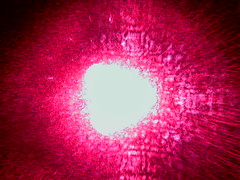Research Could Help Replace Electronic Components With Optical Technology
Electrical engineers at Duke University have developed a material that allows them to manipulate light in much the same way that electronics manipulate flowing electrons.
The researchers say the results of their latest proof-of-concept experiments could lead to the replacement of electrical components with those based on optical technologies. Light-based devices would enable faster and more efficient transmission of information, much in the same way that replacing wires with optical fibers revolutionized the telecommunications industry.
The breakthrough revolves around a novel artificial structure known as a metamaterial. These exotic composite materials are not so much a single substance, but an entire structure that can be engineered to exhibit properties not readily found in nature. The structure used in these experiments resembles a miniature set of tan Venetian blinds.
When light passes through a material, even though it may be reflected, refracted or weakened along the way, it is still the same light coming out. This is known as linearity.
“For highly intense light, however, certain ‘nonlinear’ materials violate this rule of thumb, converting the incoming energy into a brand new beam of light at twice the original frequency, called the second-harmonic,” said Alec Rose, graduate student in the laboratory of David R. Smith, William Bevan Professor of electrical and computer engineering at Duke’s Pratt School of Engineering.
As an example, he cited the crystal in some laser pointers, which transforms the normal laser light into another beam of a different color, which would be the second-harmonic. Though they contain nonlinear properties, designing such devices requires a great deal of time and effort to be able to control the direction of the second harmonic, and natural nonlinear materials are quite weak, Rose said.
“Normally, this frequency-doubling process occurs over a distance of many wavelengths, and the direction in which the second-harmonic travels is strictly determined by whatever nonlinear material is used,” Rose said. “Using the novel metamaterials at microwave frequencies, we were able to fabricate a nonlinear device capable of ‘steering’ this second-harmonic. The device simultaneously doubled and reflected incoming waves in the direction we wanted.”
Related articles
- New 3-D photonic crystal opens new avenues for solar cells, lasers (news.bioscholar.com)
- Metamaterial Could Facilitate Wireless Power (nextbigfuture.com)
- Anti-lasers spawn other anti-optical devices (arstechnica.com)
- Nanotechnology Research around the world. Israel (nanobugle.org)
- Light propagates as if ‘space is missing’ (nanotechweb.org)









